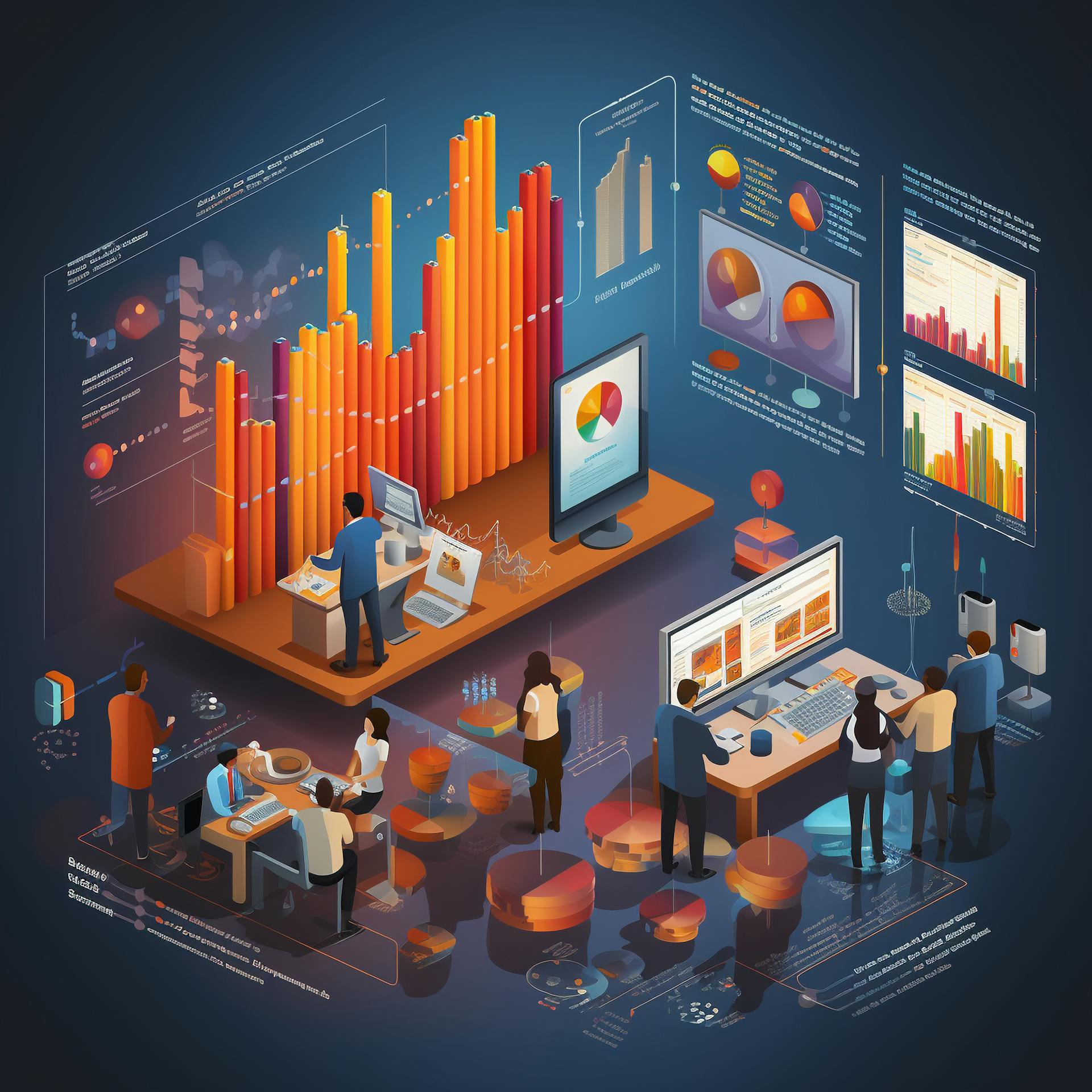For decades, Shell has been shaping global thinking with scenarios that outline the contours of the energy future. In its 2025 Energy Security Scenarios, Shell presents possible future scenarios ranging from fragmented markets to how AI could affect energy systems, and to a world on the path to net-zero emissions. Behind this vision lies a vast amount of data and calculations, and this is where ORTEC plays a role as an innovative partner. “We work as one team with Shell,” says Sven Wortel, Analytics Consultant at ORTEC. “Together, we make the complex clear.”
Shell began using scenario planning in the 1970s. Over the following decades, it grew into a globally recognized method for supporting strategic decision-making. The 2025 Energy Security Scenarios build on previous editions and introduce new themes, such as the impact of artificial intelligence (AI) on energy consumption and production. These scenarios do not make predictions but explore plausible futures. “Shell’s scenarios are not only used internally but are also shared externally to fuel the debate about the energy future,” says Sven. “That makes this project particularly special compared to other ORTEC projects; we are directly contributing to something with global impact.”

Sven Wortel, Analytics Consultant at ORTEC
"We make enormous datasets more accessible for analysts and managers."
Visualizing Datasets: Turning Complex Data into Actionable Insights
Five years ago, ORTEC saw an opportunity at Shell to transform an Excel model into a Python-based model. “With Python, we could automate and scale calculations,” says Sven. “The analyst can benefit from new features and much greater capacity whilst running the model as nimbly as before.”
This led to version 3.0 of Shell’s in-house World Energy Model (WEM). Shell also asked ORTEC to develop a data visualization solution, resulting in a Power BI report. After successfully migrating the WEM to Python and Power BI, the decision was made to do the same with another in-house model, the Global Supply Model (GSM). WEM and GSM calculate global energy demand and supply, incorporating variables such as population, GDP, CO2 prices, efficiency projections, technology introduction dates and many more, across dimensions of 100 regions, 19 energy sources, 10 energy carriers, and 19 energy sectors, covering a timeline to 2100. “The goal was to make these enormous datasets accessible to analysts and managers,” Sven explains. ”Excel had provided the team with accessibility and transparency, but it was proving unwieldy as it reached its limits in scalability. The switch to Python provided much more computing power, significantly accelerating a single iteration of running the WEM model. The analysts were pleasantly surprised by how much more scalable the Python codebase is for model enhancements. While an Excel dashboard had allowed access to the data, the development of Power BI extended the range of visualizations and made it easier for the Scenarios team to share detailed scenarios data across the company.”
The new report is another gamechanger.
It not only handles current data but is also ready for future expansions.
A Gamechanger for Speed, Scale, and Strategic Insights
As the modelling and quantification underpinning Shell’s scenarios grew in ambition and scale, especially with the 2025 Energy Security Scenarios, the Power BI report proved insufficient. “The datasets became too large,” says Sven. “We’re talking about billions of data points. To our surprise, Power BI has struggled with speed and capacity. The limitations of Power BI have also restricted what we could visualize.” It was also proving a heavy maintenance burden. Moreover, new scenarios are requiring yet greater flexibility and scalability. To help support Shell achieve this ambition, ORTEC is developing a new data report, currently a Minimum Viable Product (MVP), built on modern technologies such as Plotly Dash for interactive visualizations, Databricks for data processing, and a Data Lake for efficient storage. “The new report will be another gamechanger,” Sven says enthusiastically. “The Proof of Concept showed that it not only handles current data but is also ready for future expansions, such as greater detail in the energy data or comparison across a wider range of scenarios and dimensions.”
Another challenge for the team’s efficiency has been the extensive effort of loading new sets of runs from the WEM-Python model into the Power BI report. This new Plotly Dash report is expected to be more responsive for end users, easier to maintain for modelers, and overcome Power BI’s limitations in data visualization.
I have rarely seen such a close relationship with a client. We brainstorm as if we are colleagues.
Innovating Through Trust: How ORTEC and Shell Work as One Team
The collaboration between ORTEC and Shell is remarkably close. The team working on the World Energy Model consists of seven members, four employed by ORTEC and three by Shell, operating as one unit. “I have rarely seen such a close relationship with a client,” says Sven. This partnership extends beyond technical support: ORTEC is fully involved in working alongside the Shell team planning ahead for the platforms and systems, as well as leading on the implementation and maintenance of the models themselves. Additionally, ORTEC helps train Shell employees new to the team. “What’s special about the relationship is the close collaboration between Shell with their energy system knowledge, and ORTEC with our programming and data knowledge. Together, we identify issues and challenges, and we spar on how to navigate these challenges through building roadmaps and designs. We organize workshops to explain the report, from basic functions to advanced analyses,” says Sven. “Sometimes, we do this alongside Shell’s own team, which accelerates adoption.” According to Sven, Shell’s openness to ORTEC’s innovations is a key factor. “They could have stuck with Excel, but they trusted us enough to modernize. When we proposed the new report, they said: ‘Go for it.’ That trust – built over years of collaboration – is invaluable.”
ORTEC’s work has not only made Shell’s models more efficient but has also enriched them substantively. One example was the development of modeling of direct air capture of CO2, in 2022. At the time, it was one of the first energy system models in the world to incorporate what many point to as a major potential breakthrough technology. “We decided collectively to treat this as a new sector (i.e. and end-user of energy) so that we could track its significant energy needs most transparently. In other sectors, we model outputs, such as home heating, passenger-km or tons of steel, with CO2 as a by-product. In this new sector, by contrast, the useful output was CO2 captured. Furthermore, we also needed to adapt the model to give flexibility to users to decide what to do with the captured CO2: to store it, or to use it as a feedstock for fuels, according to the scenario story. “This flexibility allows us to analyze the full energy and emissions impact of introducing novel technologies into the model,” says Sven.

A case in point is Nature-Based Solutions (NBS), such as reforestation or carbon storage in soils. While NBS remains a separate model, ORTEC has improved the way its data is consolidated within Shell’s broader scenario analysis. Sven observes, “Four years ago, we could only incorporate NBS results in custom-built special charts. ORTEC’s innovation allows us to visualize emissions reductions in an integrated way, across energy, land and industrial process emissions, drilling down to national scale.” The place of NBS in Brazil’s decarbonization journey featured heavily in a Shell scenarios report on the country in 2024. Another area is the non-energy use sector, where oil and gas are used as raw materials for products like plastic, fertilizer, and asphalt. “Up until now the team modelling the scenarios had to summarize narratives down to the energy needed for production and processing in the models,” Sven explains. “With major Python developments under way, and the new report, we in ORTEC are equipping the Shell team to be able to explore important questions for this sector’s transition directly in the model. For example, with a separate input for levels of recycling, together with links and calculations in the WEM, the team will be able to highlight the trade-off of less virgin feedstock but greater need for processing energy.” The calibration process has also benefited from these advances. “Analysts want to adjust parameters, such as oil prices, and immediately see the impact on the scenario. With an increasing number of processes modeled in the WEM, more possible connections are revealed by the model between parts of the energy system across the world. In reflecting a scenario narrative, analysts often need to calibrate to policy targets, such as electric vehicle shares of car sales. For what previously required full model runs each time, now can be conducted with a variety of tools available to the analyst: a UI presenting intermediate results, a local dashboard, data exports linked to the database, and the integration of a goal-seeking approach within the Python codebase.”

Sven Wortel, Analytics Consultant at ORTEC
"Analysts want to adjust parameters and instantly see the impact on scenarios, and we are continuously striving for greater automation to achieve this. Our goal is to streamline the process of maintaining, calibrating, and running the model, allowing the team to focus more on the real use and interpretation of the data, rather than on manual tasks."
Global Impact: Shell’s Scenarios Shape Energy Strategy
Shell Scenarios have a significant impact both within Shell and beyond. “The most recent 2025 Energy Security Scenarios were used by Shell’s management as part of the company’s Capital Markets Day discussions with their key investors” says Sven. “They were also distributed to stakeholders worldwide – from governments to CEOs and academic influencers.” Publicly, the scenarios attracted attention from media outlets such as Reuters and Bloomberg. “That shows how relevant our work is,” Sven explains. The Shell Scenarios are also adapted for regional analyses. “In Brazil, for example, they examined the role international CO2 trading developments could play in helping to turn around the emissions of Brazil’s land sector. Insights like these help Shell develop local strategies.”
How AI Is Transforming the Future of Energy Modeling
The 2025 Energy Security Scenarios introduce AI and its potential to be transformative as a central theme, particularly in the Surge scenario. While the focus today is on the electricity used to power data centers, AI's impact on energy could be far more wide-ranging. “AI can optimize processes, but its energy consumption is exploding,” warns Sven. “We now explicitly model this because it could radically change the energy markets.” ORTEC is also exploring AI within its own tools. “We are studying the possibilities of a chatbot that helps analysts quickly retrieve data. Imagine asking, ‘How much oil will China use in 2040?’ and instantly getting an answer with a chart.” Another application is AI that automatically generates interpretations for visualizations. “Such AI use-cases would make the scenarios more accessible to non-experts,” Sven explains.
Strong Partnership Between Shell and ORTEC
The collaboration between ORTEC and Shell is more than a standard customer-supplier relationship: ORTEC has been a trusted partner of Shell for 40 years, while the collaboration on the Shell Scenarios has evolved over the past eight years. The success of our common history is built on three core principles:
1. Close Collaboration
ORTEC aims to be seen not as an external consultant but as an integral part of Shell’s team. This principle fosters a close connection and an efficient way of working together. In practice, this means ORTEC employees work side by side with Shell’s, i.e. sharing information, participating in brainstorming sessions, and attending internal meetings. As a result of this integration, ORTEC also contributes to workshops organized internally by Shell, for example, to clarify intersections with WEM or GSM, discuss scenarios, or explain report functionalities. The outcome is an atmosphere of trust and shared ownership, where ideas flow freely, and decisions are made quickly.
2. Efficiency Improvement
Continuously improving processes is a second pillar of ORTEC’s approach. The goal is to optimize time and resources, whether in data processing, modeling, or the use of parameters in scenarios. ORTEC actively seeks ways to eliminate bottlenecks. One example is the transition from Excel to Python for energy models: where calibrating scenarios used to take weeks, at a detailed level, automation has now reduced this to just two or three days. This allows the Shell team more time to engage in the reflection and testing of scenario narratives under development with the wider team and other stakeholders. This focus on efficiency enables Shell to work faster and more accurately, which is crucial for analyzing complex scenarios and responding to new developments.
3. Maximizing Output
The third principle focuses on supporting the Scenarios Team’s wish to make the extensive data behind the scenarios generally available across Shell. Tools such as the Power BI report and the upcoming Plotly Dash report play a key role in this: with a single click, managers and executives can view global energy trends or zoom in on specific regions. This makes data more accessible and increases its impact, from analysts to top management.

Key Outcomes from Shell’s 2025 Energy Security Scenarios
The 2025 Energy Security Scenarios explore different types of scenarios. Archipelagos and Surge are exploratory scenarios. They start from a set of fundamental principles and drivers, examining how the world might develop based on these assumptions. Horizon, on the other hand, is a normative scenario, setting a fixed point in the future (global net-zero CO2 emissions in 2050, in this case) and analyzing what developments are needed to reach that point.
1. Archipelagos: A Fragmented World
The Archipelagos scenario depicts a world of geopolitical fragmentation, where countries turn inward, and protectionism rises. This has far-reaching consequences for the energy market:
- Patchy energy transition: Global climate goals take a backseat to national interests, but the energy transition still proceeds in different ways in different places when it suits national security needs.
- Trade barriers: Restrictions on technology and raw material trade, such as rare metals for batteries, make clean technologies more expensive and less accessible than in more globalized scenarios. Solar panel deployment still proceeds apace but doesn’t meet all the potential because of trade frictions.
- Regional focus: Shoring up the existing energy system takes priority, leading to increased local production, e.g. shale gas or coal, at the expense of emission reductions.
2. Horizon: A Path to Net-Zero Emissions
Horizon is an ambitious scenario that outlines what is necessary to achieve net-zero CO2 emissions by 2050 and less than 1.5°C of global warming by 2100. It requires international cooperation at the same time as vigorous competition, strict policies, and technological breakthroughs:
- Rapid electrification: A global shift toward electricity for transport, heating, and industry
- Renewable energy: Massive investments in wind, solar, and hydrogen, supported by battery technology and carbon capture.
- Global policy: A worldwide carbon price and subsidies for clean technologies are essential. A concrete example is the development of a global hydrogen network, requiring international agreements on standards.
Note: In The 2025 Energy Security Scenarios, the scenario that illustrates a possible pathway to net-zero CO2 emissions in 2050 has been renamed Horizon.
3. Surge: The Influence of Technology and AI
In the Surge scenario, technology, particularly artificial intelligence (AI), plays a central role in the energy transition:
- Rising energy demand: AI sees rising electricity need for data centers, but much more significantly it spurs new technologies to drive an economic productivity boost resulting in a significant increase in energy consumption.
- Efficiency through innovation: AI optimizes production, logistics, and energy management, increasing overall efficiency. Since AI contributes to economic growth, governments are also keen to embrace it.
- Accelerated development: Breakthroughs in battery technology, smart grids, and autonomous systems accelerate the adoption of renewable energy. The report highlights a dual effect: AI could significantly increase energy demand by 2050, whilst at the same time, it supports the rapid electrification of the energy system, thereby increasing the system’s efficiency.
For more information on Shell’s scenario approach, click here.
About Sven Wortel
Sven Wortel, Analytics Consultant at ORTEC, has been a part of the Shell World Energy Model project team for almost 3 years now and he joined the Global Supply Model project team earlier this year. Throughout his years of work, Sven has built and fostered a great relationship with the client. He has worked closely with the Shell Energy Fundamentals team to help them model, quantify, and visualize the data behind the Shell Scenarios.

Frequently Asked Questions
In this interview, Sven Wortel, Analytics Consultant at ORTEC, shares how close collaboration with Shell enables the teams to build and maintain advanced scenario planning tools turning complexity into clarity for energy strategy decisions.
What are Shell’s Energy Security Scenarios?What are Shell’s Energy Security Scenarios?
Shell’s 2025 Energy Security Scenarios outline future energy landscapes, from geopolitical fragmentation to a net-zero world.
Why are scenario models important for energy strategy?
Shell’s scenarios are not only used internally but are also shared externally to fuel the debate about the energy future.
How does ORTEC support Shell in scenario modeling?
Behind this effort is ORTEC, facilitating the modeling of energy outlooks, building and supporting large models and datasets. By leveraging Python, Power BI, and AI-driven reports, ORTEC accelerates and extends scenario development, enhancing decision-making for Shell’s leadership and beyond.
How do Shell’s scenarios impact global energy policy?
Shell Scenarios have a significant impact both within Shell and beyond. “The most recent 2025 Energy Security Scenarios were used by Shell’s management as part of the company’s Capital Markets Day discussions with their key investors” says Sven. “They were also distributed to stakeholders worldwide – from governments to CEOs and academic influencers.”
What makes the Shell-ORTEC partnership unique?
The collaboration between ORTEC and Shell is remarkably close. The team working on the World Energy Model consists of seven members, four employed by ORTEC and three by Shell, operating as one unit.
What is the focus of Shell’s 2025 Energy Security Scenarios? What is the focus of Shell’s 2025 Energy Security Scenarios?
In its 2025 Energy Security Scenarios, Shell presents possible future scenarios ranging from fragmented markets to how AI could affect energy systems, and to a world on the path to net-zero emissions.
What role does AI play in Shell’s scenario planning?
The 2025 Energy Security Scenarios introduce AI and its potential to be transformative as a central theme, particularly in the Surge scenario.
Want to learn more about how ORTEC supports energy transition leaders like Shell?
Get in touch with our experts or explore our energy insights.





